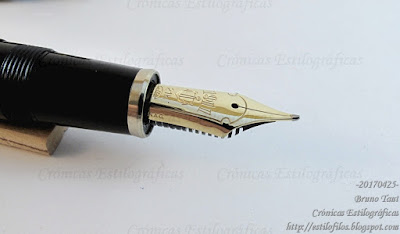
The three points of the Custom Urushi (FM, M, B) ready to be tested. And a Custom 845 on the right hand side.
The size 30 nib has created a new category in Pilot’s catalog of pens, a category in between sizes 15 and 20, on one side, and size 50 on the other. Sizes 20 and 50 are exclusive to Namiki pens, and are implemented on models Yukari Royale, size 20, and Emperor, size 50, including the Urushi Series in black (ro-iro) and red (shu). Pilot’s size 15 nib is implemented in a number of Custom models: 743, 823, 845, Ichii (一位), Enju (槐). Let us remember, finally, that sizes 15 and 20 are very similar, like KMPN showed on his reference post on the matter.

The insides of the Custom Urushi (top) and of the Custom 845 (bottom). Their ink converters are the same--CON-70.
Externally, the new Pilot Custom Urushi (JPY 88000), as shown on these pages some months ago, is little else than an oversized Custom 845 (JPY 50000). Both pens are coated with urushi, and on both of them the section and the finials on cap and body are made of black plastic. Interestingly enough, both pens use the same ink converter –the CON-70— and, therefore, the bigger size of the Custom Urushi does not enjoy any difference on the filling system.
Cheaper (JPY 30000) Custom models with size 15 nibs –Custom 743 and 823— are all made of plastic and their gold purity is lower: 14 K Au vs the 18 K of the Custom 845, Ichii, Enju, and Custom Urushi. On the higher end, the Yukari Royale-size pens of the Urushi Series (nib size 20) are made of brass and are totally coated with urushi. Their price is JPY 128000.
| Model | nib size material |
nib points | filling system ink capacity (ml) (1) |
price (JPY) (2) |
| 743 | 15 14K Au |
14 -EF-F-SF-FM-SFM-M-SM- -B-BB-PO-FA-WA-SU-C- |
C/C CON-70 - 1.0 ml |
30.000 |
| 823 | 15 14K Au |
3 F-M-B (3) |
plunger - 2.2 ml | 30.000 |
845, Ichii (一位) (4), Enju (槐) (5) |
15 18K Au |
4 F-M-B-BB (3) |
C/C CON-70 - 1.0 ml |
50.000 |
Custom Urushi |
30 18K Au |
3 FM-M-B |
C/C CON-70 - 1.0 ml |
88.000 |
| Namiki Urushi #20 |
20 18K Au |
3 F-M-B |
C/C CON-70 - 1.0 ml |
128.000 |
NOTES: Data according to Pilot's and Namiki's catalogs.
(1) C/C: cartridge and converter. Other converters (CON-20, CON-40, CON-50) can also be used. Their ink capacities are smaller than that of the CON-70.
(2) Catalog prices without taxes (8% in Japan).
(3) At some shops, Custom 823 and Custom 845 can be found with some other nib points.
(4) Custom Ichii pen only has two nib points available: F and M.
(5) Custom Enju comes in three nib points: F, M, and B.
Comparative chart of the Pilot and Namiki models with nibs of sizes 15, 20, and 30.
(1) C/C: cartridge and converter. Other converters (CON-20, CON-40, CON-50) can also be used. Their ink capacities are smaller than that of the CON-70.
(2) Catalog prices without taxes (8% in Japan).
(3) At some shops, Custom 823 and Custom 845 can be found with some other nib points.
(4) Custom Ichii pen only has two nib points available: F and M.
(5) Custom Enju comes in three nib points: F, M, and B.
Comparative chart of the Pilot and Namiki models with nibs of sizes 15, 20, and 30.
The obvious question now is whether the Pilot Custom Urushi might be stealing some of the market of the Namiki pens with nib size 20. Those JPY 40000 of difference in their prices, together with the much bigger nib of the cheaper of Custom Urushi might be hard to overlook when comparing both pens: Custom Urushi and Namiki Urushi Series 20.
And looking at the comparative chart, some might go back to considering the well known Custom 823 as an excellent value. And this might be the right time to speak about that pen in depth.
Sheaffer’s TM Admiral – Pilot Iroshizuku Ku-jaku
Bruno Taut
Shinjuku, June 15 2017
etiquetas: Pilot, plumín, mercado, urushi
Bruno Taut
Shinjuku, June 15 2017
etiquetas: Pilot, plumín, mercado, urushi


























































